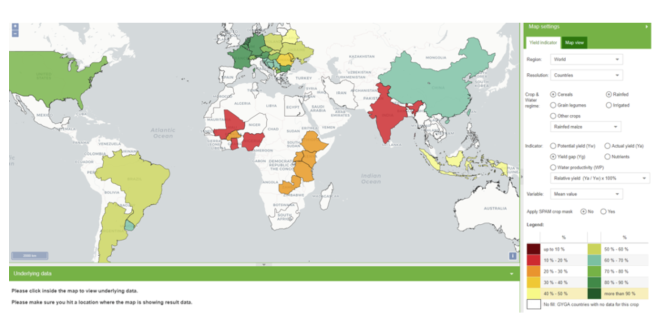Student information
Yield Gap analysis
Contact persons:
Martin van Ittersum: martin.vanittersum@wur.nl
Pytrik Reidsma: pytrik.reidsma@wur.nl
Marloes van Loon:marloes.vanloon@wur.nl
Feeding a growing population within the planetary boundaries is one of the grand tasks of humankind in the 21st century and at the heart of multiple Sustainable Development Goals (SDGs). Implications of this vary across the world. In sub-Saharan Africa a tripling food demand is anticipated by 2050, which means production of nutritious food must increase at unprecedented rates. In other regions, such as North-western Europe, developing resource-use efficient food production is a key priority to deal with the challenges of finite resources and environmental pressures.
Local data with global relevance on agricultural production, resource use and environmental implications are critical to address simultaneously questions of food availability, finite resources, and environmental impacts. As we have demonstrated through the Global Yield Gap Atlas, such data can reveal a gap between actual and potential production (the yield gap), quantifying where improvement of agricultural management can increase yields, and which resources (land, water, nutrients, etc.) are in under- or oversupply. The Atlas brings together all biophysical knowledge on todays and future crop yields and land, water and nutrient use of the world’s major food crops, including effects of climate change. Scientifically, it allows to assess the possibilities to feed growing populations with finite resources, within the planetary boundaries. Societally, it provides decision-makers with robust data to develop pathways in sustainable agricultural development and resource use and conservation.

Yield gap studies in European farming systems
Yield gaps can be decomposed into efficiency, resource, and technology yield gaps. In intensive agriculture, the resource and technology gaps are often small, and the yield gap is mainly explained by the efficiency gap. This implies that inputs are not efficiently used, and resource use efficiency can be increased. Despite the relatively small overall yield gaps, yields still vary across farms, across fields and within fields, and understanding and managing this yield variability allows to reduce the overall yield gap. In your thesis you can contribute to understanding variability in yields and resource use efficiencies, using on-farm experiments, data analysis and crop modelling (link with theme 8 and 9). In PPS, there is specific focus on the Netherlands, and its main arable crops, like potato, wheat and sugar beet.
Yield gap analysis in perennial crops
Most perennial crops are cultivated in former forested areas and further deforestation is highly undesirable for reasons of biodiversity and carbon loss. In response to higher consumer demands it is therefore preferred to increase yield on existing hectares instead of area expansion. Especially for smallholders, actual yields are far below potential yields. Since 2018 yield gap analysis in oil palm has therefore been conducted in Indonesia in which potential and water limited yields have been assessed using PALMSIM crop growth simulation model. Currently data are collected to allow assessment of the biophysical and socio-economic factors responsible for the yield gap. Further research is needed to assess the relative contribution of these factors. We also aim to test the use of PALMSIM for yield gap analysis in other oil palm areas such as Colombia and Malaysia. Furthermore, it is important to explore climate change effects on potential and water limited yield. A second perennial crop of interest is cocoa, which is mainly grown in West Africa. Climate change threatens to decrease suitability of parts of West Africa for cocoa in the future. Different topics around cocoa yield gap analysis using the CASE2 model and farmer collected data as well as effects of climate change on future yields and yield gaps can be offered. Research into the different factors responsible for yield gaps is another option. For both perennial crops there is interest in making a farm typology and in further investigating why certain farmers have larger yield gaps as this may provide insights in farmer specific options to sustainably increase yields to partially close the yield gap.
Yield gap analysis under climate change
This sub-theme extends the methods of yield gap analysis employed in the Global Yield Gap Atlas with climate change. Suitability of crop growth will change as a result of climate change, and as a consequence crop areas may shift. Potential yields in particular climate-soil zones will change. Thesis work can contribute to extend the methodology for the Atlas and apply it to some defined crops and countries (e.g., sub-Saharan Africa, Europe, cereals, cassava, potato).
Narrowing yield and nutrient gaps in sub-Saharan Africa
Closing yield gaps will require an improvement in management and either an increase in the efficiency with which inputs such as nutrients are used and/or an increase in the amount of inputs. Sub-Saharan Africa is plagued with relatively low yields, combined with very low external nutrient inputs. Only increasing the efficiency will therefore most likely not result in the desired changes. In an MSc thesis, you can explore the minimum nutrient requirements for a range of crops or countries, using different scenarios of yield gap closure, combined with different management options. In addition, you can assess data from field experiments to assess impacts on the environment (such as greenhouse gas emissions) or economics of different scenarios. From a methodological point of view you thereby contribute to the benchmarking of nutrient use and nutrient use efficiency (and thus also to benchmarking of emissions). This allows the comparison of farm performance with theoretically best values, indicating the scope for improvement.